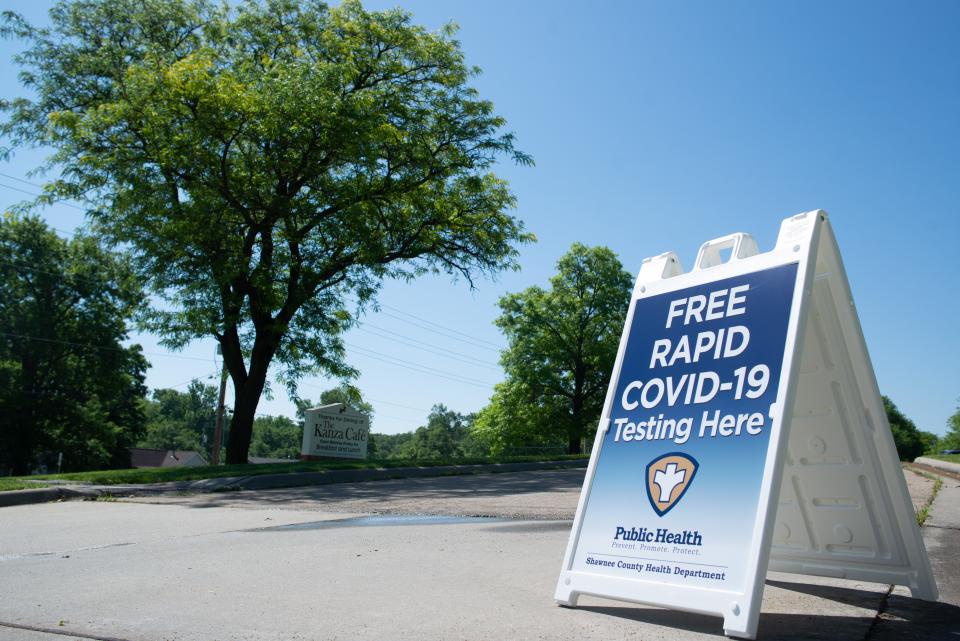Kansas COVID cases surge with BA.5 subvariant, but hospitalization and death rates remain low
Despite surging COVID-19 cases amid the BA.5 subvariant's emergence in Kansas, hospitals aren't facing the same pressures from sick patients that previous coronavirus waves brought on.
While the weekly case rate is about double what is considered to be the red zone threshold, Kansas has comparatively one of the better case rates nationwide, according to data from the federal government and the Kansas Department of Health and Environment.
Similarly, Kansas has one of the lower death rates and is in the middle of the pack on new hospital admissions.
But a staggering positive test rate of 25% in Kansas is among the highest in the country, likely in part a function of having among the fewest tests performed per capita. Positivity rates are highest among children younger than 5.
The figures don't include at-home COVID-19 tests that go unreported.

What are the new BA.5 subvariant symptoms?
Cases and positive test rates have steadily risen as the BA.5 subvariant emerged more frequently in sequencing data over the past two months.
The most recent KDHE sequencing data indicates the BA.4 and BA.5 omicron subvariants now account for about 81% of new cases. BA.5 is the dominant strain in the country.
Symptoms of the newer strains are similar to other variants, with cough, fatigue, headache and muscle pains common. Loss of taste and smell is less common now, USA TODAY reported.
Illness also seem to be less severe, possibly due to a mix of immunity from vaccination and prior infection.
More: COVID-19 cases on the rise: What to know about the state of the pandemic
Where can I get tested in Kansas?
Testing is available for free at locations across Kansas, including pharmacies, health care providers and some employers. Locations can be found online via the KDHE COVID-19 Testing Map.
Free at-home tests from the federal government can be ordered at covidtests.gov or by calling 800-232-0233. At-home rapid tests can also be purchased at a pharmacy, which may be covered by health insurance.
Are COVID patients being hospitalized?
"There are unreported cases because of at-home testing or no testing at all, so really the hospitalizations tend to be the best benchmark," said KU infectious disease specialist Dana Hawkinson.
After rising admission numbers at The University of Kansas Health System, patient counts have been more sustained at the flagship hospital in Kansas City, Kan.
"I'm being optimistic and hoping it's going to go down in the next couple weeks," Hawkinson said Wednesday.
About 4.2% of all emergency department visits are for COVID-19, KDHE data show. That's up from a low of 0.5% in early April, but far below the high of 15.6% in mid-January.
Federal data show Kansas is in the middle of the pack on ER visits for COVID-19. Coronavirus patient hospital admissions per capita also in the middle of the pack, while admissions compared to inpatient beds are among the lowest in the country.
More: New COVID variant is spreading across the US. Here's what you need to know about BA.2
The 302 hospitalizations with COVID-19 included 15 youths, though the vast majority of admissions were senior citizens.
Federal charts show hospitalizations aren't rising as quickly as cases are.
Along with high community transmission indicators, "We do have a lot more" hospitalizations than the low counts a few months ago, KU chief medical officer Steve Stites said. "But our death rate is staying relatively low and I think it's the overwhelming large percentage of people now who have been vaccinated who have really helped that."
What are the Kansas vaccination rates?
Federal data show Kansas is up to 73.3% of the population with at least one dose, 62.6% who are fully vaccinated and 45.3% of fully vaccinated people who have gotten a booster.
Vaccine uptake has been lower among children, with only 31.2% of the 5-11 age group with a first dose. The 12-17 age group's one-dose vaccination rate is 61.8%.
Among adults, 85.7% have gotten at least one shot.
All of those Kansas vaccination rates are in the middle of the pack nationwide.
No vaccination data is available for children younger than 5, who became eligible for Pfizer and Moderna shots late last month with time to get fully vaccinated before the start of the school year.
"The vaccine remains the best way to protect from serious illness," KDHE Secretary Janet Stanek said in a June statement. "This important development will help keep children safe and stop the spread of COVID-19."
More: Kansas pre-ordered 66,800 doses of COVID vaccines for youngest children
Where can you get vaccinated in Kansas?
The KDHE Find My Vaccine online tool and vaccines.gov can help you find nearby providers, whether they have doses on hand and how to contact them. Vaccines are free and no insurance is required, though providers are permitted to charge an administration fee.
Second boosters may be recommended to everyone in coming weeks, Hawkinson said. Older people especially benefit from an extra dose.
A federal advisory panel has already supported reformulating COVID-19 boosters for the fall to more directly target the omicron variant.
More: FDA panel approves reformulating COVID boosters to fight 'risk of major outbreak' this fall
Jason Tidd is a statehouse reporter for the Topeka Capital-Journal. He can be reached by email at jtidd@gannett.com. Follow him on Twitter @Jason_Tidd.
This article originally appeared on Topeka Capital-Journal: BA.5 COVID variant brings case surge in Kansas; hospitals not strained

